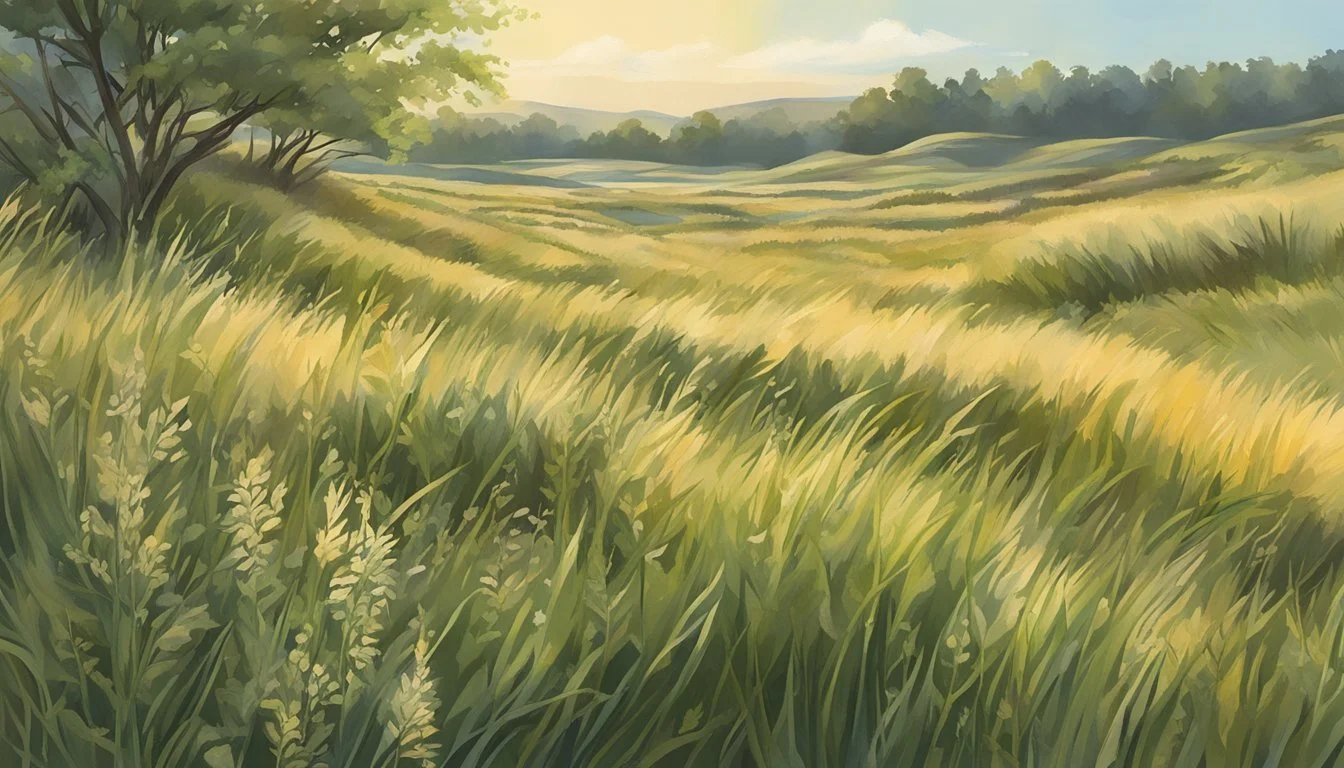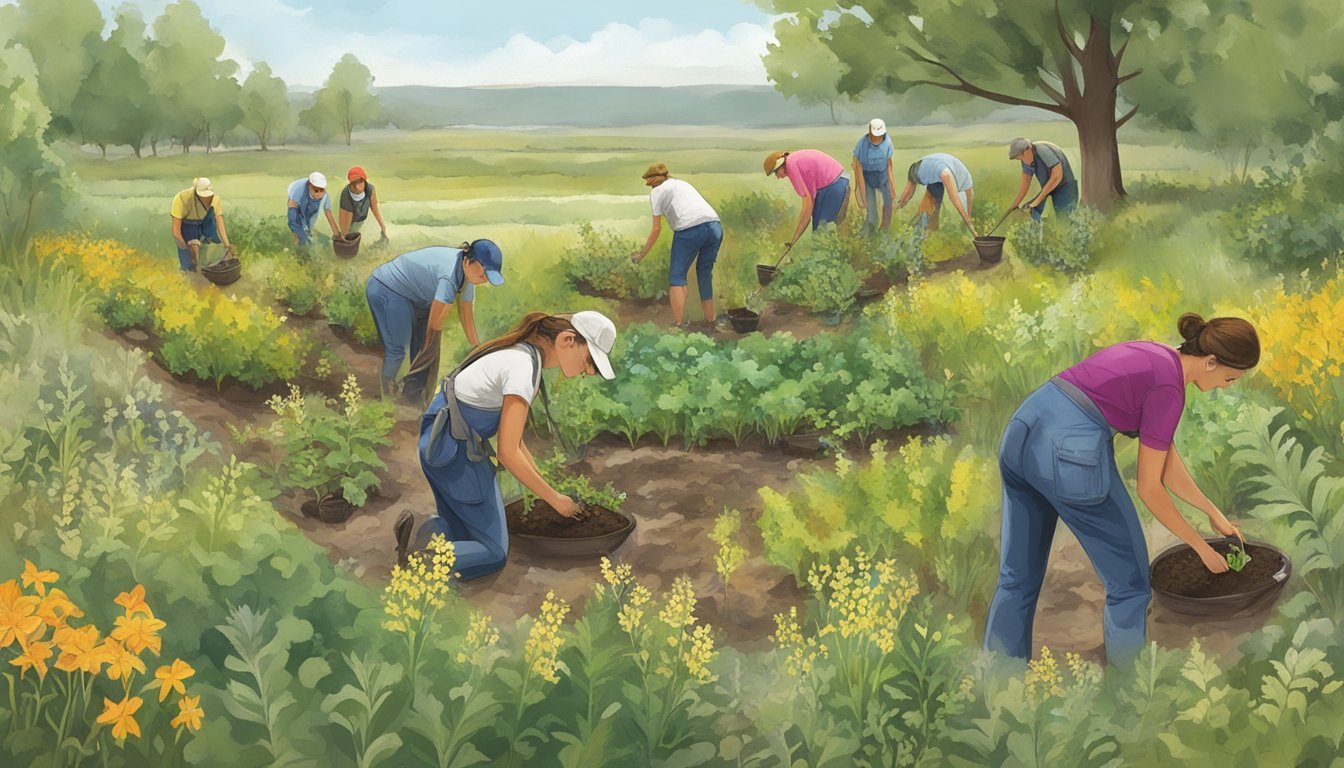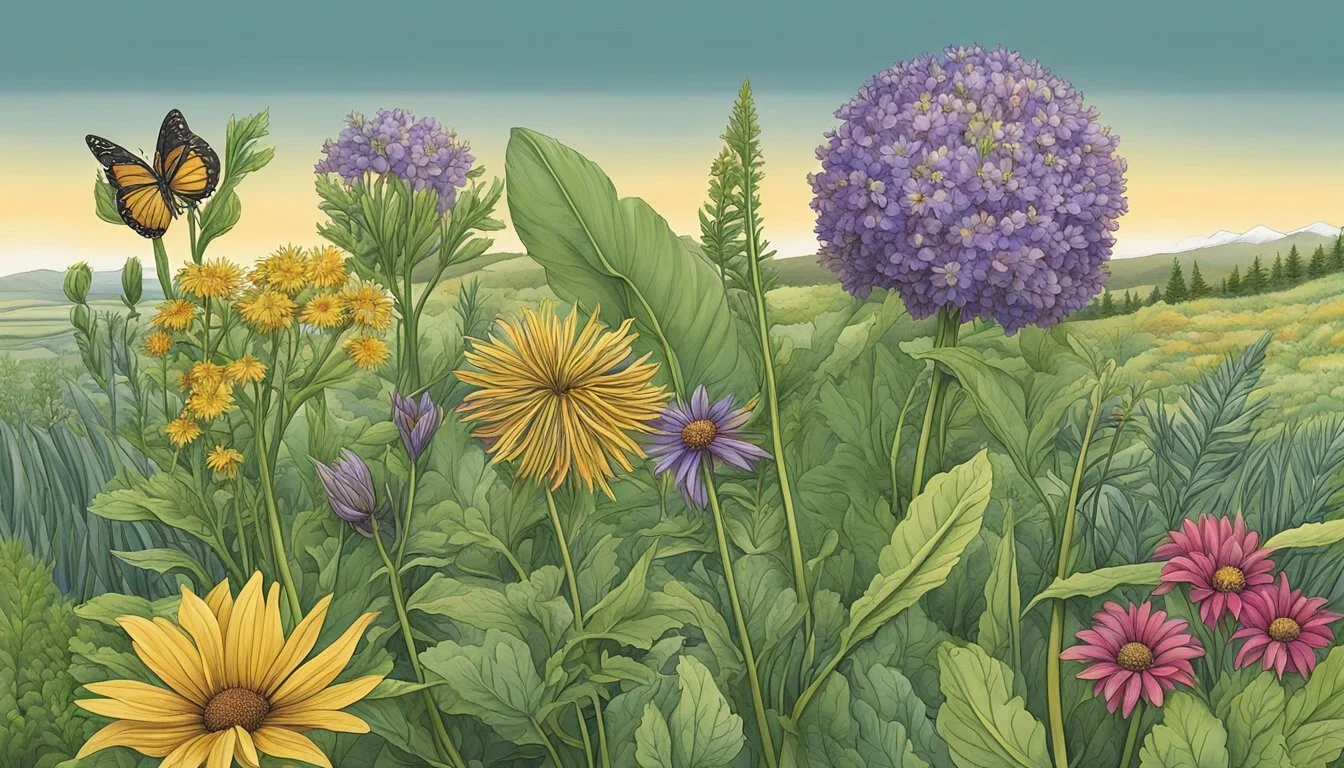Native Edible Plants in South Dakota
A Forager's Guide
This Article is Part of Foraging Guide for All 50 US States
South Dakota's diverse landscape, stretching from the Badlands and the Black Hills to expansive prairies, is home to a plethora of native plants that have fed its inhabitants for centuries. These native edible plants are an integral part of the region's ecosystem, offering not only sustenance to humans but also playing a crucial role in supporting local wildlife. Foraging for these plants allows one to connect with the environment and tap into a tradition that the Lakota and other indigenous peoples have practiced long before European settlers arrived.
Among the abundance of flora, certain species stand out for their nutritional value and ease of identification. Wild berries, such as chokecherries and juneberries, are commonly found and have long been harvested by the region's residents. These small fruits are typically used in traditional recipes, ranging from sweet preserves to savory sauces that complement game meat. Additionally, the prairies are dotted with native herbs and greens, like the prairie turnip and wild bergamot, which contribute unique flavors to the local cuisine.
Understanding these plants' roles within South Dakota's environment is vital for both foragers and conservationists. Many native edible plants are adapted to the climate and soil conditions of the region, making them resilient to weather changes and beneficial for maintaining soil health. Their presence often indicates a healthy and balanced ecosystem, and their usage by humans can promote biodiversity. By respecting these native species and their habitats, South Dakotans can preserve an important element of their natural heritage while enjoying the flavors these plants have to offer.
Interested in Mushroom Hunting in South Dakota?
South Dakota's varied landscapes, from the Black Hills to the prairies, offer diverse opportunities for mushroom hunting. The state is home to several edible mushroom species, including morels, chanterelles, oyster mushrooms, and puffballs. The best time to hunt for mushrooms in South Dakota depends on the species and location, but generally falls between spring and fall. The Black Hills National Forest and Custer State Park are popular spots for foraging. As with any mushroom hunting adventure, proper identification skills and respect for the environment and private property are essential for a safe and enjoyable experience in South Dakota's rugged and beautiful wilderness.
👉 Guide on Mushroom Hunting in South Dakota
Historical Significance of Native Edible Plants
Native edible plants in South Dakota have held significant cultural and nutritional value for indigenous peoples. Their roles bridged sustenance, medicine, and tradition.
Traditional Uses by Indigenous Peoples
Indigenous groups in South Dakota, such as the Lakota, Dakota, and Nakota tribes, have a deep-rooted knowledge of native plant species and their applications. Timpsila or prairie turnip (Pediomelum esculentum) was a staple carbohydrate for these peoples. Berries, like the chokecherry (Prunus virginiana), provided essential vitamins and were incorporated into pemmican, a dense and nourishing food suitable for storage. Medicinal teas were brewed using plants like the purple coneflower (Echinacea spp.), recognized for its immune-boosting properties.
Historical Harvesting Practices
Historical harvesting methods were both sustainable and respectful of the land. Research suggests these practices included timed harvests to ensure plant populations' regeneration. Specifically, the collection of wild plums (Prunus americana) and other edible fruit was carried out with a balance, maintaining enough fruit for wildlife and for the plant to reproduce. Preservation techniques, such as drying and smoking, allowed natives to store crops for use throughout harsh seasons. The use of these methods illustrates a sophisticated understanding of ecology and food security that was integral to historical Native American cultures.
Native Plant Identification
Proper identification of native plants is essential for anyone interested in foraging for edible species. It helps distinguish between safe and potentially harmful plants, ensuring a safe foraging experience.
Recognizing Edible Flowers and Grasses
Edible flowers and grasses are abundant in South Dakota, but they must be identified with precision to avoid harmful species. Flowers such as the Prairie Violet (Viola pedatifida) and Wild Bergamot (Monarda fistulosa) are distinct with purple hues and unique petal formations. When identifying grasses, look for Western Wheatgrass (Pascopyrum smithii), recognizable by its slender, blue-green leaves and the Indian Ricegrass (Oryzopsis hymenoides), noted for its needle-like leaves and airy seed heads. These species are confirmed as edible through their visual characteristics:
Prairie Violet (Viola pedatifida): heart-shaped leaves, deep violet flowers.
Wild Bergamot (Monarda fistulosa): lavender flowers in dense clusters, fragrant leaves.
For safety, cross-reference visual identification with reliable field guides.
The Unique Flora of Black Hills and Prairies
The Black Hills region supports a diverse range of plant life distinct from the surrounding prairies. Notably, the Timber Milk-Vetch (Astragalus miser) thrives here, with its pale yellow flowers and feathery foliage. In contrast, the expansive prairies offer edible plants like the Purple Coneflower (Echinacea angustifolia), which is characterized by its large, daisy-like purple flowers and spiny central cone.
Specific identification features include:
Timber Milk-Vetch (Astragalus miser): small, yellow flowers in clusters, pinnately compound leaves.
Purple Coneflower (Echinacea angustifolia): sharp-toothed leaves, purple petals drooping from a dark cone.
Knowledge of these key identification markers is central to safely finding and utilizing South Dakota's native edible plants.
Growing Conditions
The productivity of native edible plants in South Dakota relies heavily on the specific soil types and the effects of the seasonal climate. Variations in these factors play a crucial role in the growth and sustainability of the vegetation.
Soil Types and Health
South Dakota’s soil largely consists of fertile prairie soils, which include variations such as silt loam, clay, and loamy sand. These soils are inherently rich in organic matter, promoting the growth of a diverse range of native plants. The health of the soil is essential for the growth of drought-tolerant species, which thrive in well-drained conditions. Soil health is assessed by its structure, nutrient content, and the presence of beneficial microorganisms.
Soil Type Characteristics Native Plants Suited Silt Loam Well-balanced; good moisture retention Wild bergamot Clay Higher nutrient content; slower drainage Prairie coneflower Loamy Sand Fast drainage; low water retention Pasque Flower
Plants that thrive in sandy loam are especially tolerant of drought due to their deep root systems that can access lower soil moisture levels. Shade tolerance varies among species, with some such as the purple prairie clover (Dalea purpurea) preferring full sunlight, while others can handle light to moderate shade.
Seasonal Climate Impacts on Vegetation
The climate of South Dakota fluctuates with distinct seasons, which includes warm, wet springs that usher in robust plant growth, followed by hot summers that test the drought tolerance of the local flora. Variability in the amount of sunlight and moisture results in a diverse array of plants that have adapted to these conditions.
Springs: Adequate rainfall allows for a brief but vibrant period of growth for many plants.
Summers: Intense sunlight and periods of drought necessitate drought-tolerance. Plants like the leadplant (Amorpha canescens) are adept at surviving these tough conditions.
Falls: Cooler temperatures and reduced sunlight lead to a slowdown in growth, preparing plants for winter.
Winters: Cold and snow dominate, with hardy perennials surviving until the next warm season.
Anticipating the impacts of each season is integral for understanding the growth cycles of native edible plants such as chokecherries (Prunus virginiana) and wild plums (Prunus americana), which are capable of withstanding the rigors of the South Dakota climate.
Ecological Benefits
Native edible plants in South Dakota play a crucial role in sustaining the area's ecosystems by supporting various life forms and contributing to the region's natural diversity.
Supporting Local Wildlife and Pollinators
Habitat Support: Many native species, such as the Purple Prairie Clover (Dalea purpurea) and Wild Plum (Prunus americana), provide essential habitats for local wildlife. These plants offer shelter and food sources which are needed for species' survival and reproduction.
Pollination Networks: Native plants like the Leadplant (Amorpha canescens) support pollinators including bees, butterflies, and birds. Their flowers are specifically adapted to local pollinators, facilitating a mutualistic relationship where plants provide nectar while pollinators aid in their reproductive process.
Contribution to Biodiversity
Gene Pool Strengthening: Local flora such as the Chokecherry (Prunus virginiana) encompass a wide gene pool that increases the overall resilience of the ecosystem to diseases, pests, and climate change.
Ecosystem Complexity: The presence of a diverse array of indigenous plants like Ramps (Allium tricoccum) underpins a complex ecosystem. Each plant fulfills a unique niche, contributing to the intricate web of life that sustains a thriving biosphere.
Cultivation and Care
When gardening with native plants in South Dakota, gardeners should focus on perennial species for a low-maintenance yet active garden. Propagation and seedling care are crucial for establishing a thriving native garden.
Propagation Techniques and Seedling Care
For successful propagation, one must understand the specific needs of each plant species. Native perennials often require stratification, a process that mimics natural winter conditions.
Stratification:
Mix seeds with moist sand or peat moss.
Seal in a plastic bag and refrigerate for several weeks.
Following stratification, seedlings need a proper growing medium that mimics their natural soil conditions. Light, well-drained soil is often ideal. Once seedlings emerge, they should be kept in a location that receives ample sunlight and is protected from strong winds. Regular watering helps establish a strong root system, but overwatering can be detrimental.
Seedling Care Instructions:
Sunlight: Minimum of 6 hours per day.
Watering: Once the top inch of soil is dry.
Transplanting: When seedlings have 2-3 true leaves.
Gardening With Native Species
Gardening with native plants offers a symbiotic relationship with local wildlife and is typically low-maintenance. Perennials like the purple coneflower (Echinacea purpurea) and the blanket flower (Gaillardia aristata) are popular choices.
Plant Sunlight Requirements Soil Preferences Watering Needs Purple Coneflower Full sun to part shade Well-drained, loamy Moderate; drought-tolerant Blanket Flower Full sun Well-drained, sandy/loamy Low; drought-tolerant
Mulch can be added to conserve moisture and suppress weeds. Native species often require less fertilizer and are more resistant to local pests and diseases. Regular inspection and minimal pruning encourage healthy growth and prevent overcrowding.
Practical Uses and Application
This section explores the specific parts of local flora that are edible and their health benefits, alongside the medicinal uses of South Dakota's plants.
Edible Parts of South Dakota Plants
The region's native botany offers a variety of edible parts. For instance, the fruit of the Prunus americana, also known as the American Plum, can be consumed fresh or used in preserves. Below is a list of plants with edible components:
American Plum (Prunus americana): Fruit
Chokecherry (Prunus virginiana): Fruit, after processing to remove toxicity
Wild Grape (Vitis riparia): Fruit, leaves used for wrapping food
Prairie Turnip (Pediomelum esculentum): Tubers, raw or cooked
Medicinal Applications and Health Benefits
The traditional knowledge of medicinal plants in South Dakota is vast. Several plants are valued for their health benefits.
Echinacea (Echinacea spp.): Enhances immune system functionality.
Wild Bergamot (Monarda fistulosa): Antiseptic properties, used in treating colds.
A table to summarize:
Plant Medicinal Use Notes Echinacea Immune support Often used in cold prevention Wild Bergamot Antiseptic Helps with respiratory issues
These applications are a testament to the diverse and practical uses of South Dakota's native plants.
Conservation and Restoration Efforts
Efforts in South Dakota are focused on combating the adverse effects of invasive species on native edible plants and implementing restoration projects to conserve the environment.
Impact of Invasive Species
Invasive plant species pose a significant threat to South Dakota's native flora. Burdock (Arctium minus), Canada thistle (Cirsium arvense), and Leafy spurge (Euphorbia esula) are among the invasives that disrupt local ecosystems by outcompeting native species for resources. Efforts to control these species include:
Physical removal: Manual extraction of plants from the ground.
Herbicide application: Targeted use of chemicals to eradicate invasive species without affecting native plants.
Education campaigns: Programs designed to inform the public about the identification and management of invasives.
Restoration Projects
Restoration projects aim to reestablish the vitality of South Dakota’s indigenous plant species and preserve the environmental balance. Key projects involve:
Seed harvesting and propagation: Collection of seeds from native edible plants like chokecherry (Prunus virginiana) and timpsila (Psoralea esculenta) to increase their population.
Reintroduction initiatives: Transplanting of propagated native species into their natural habitats to enhance biodiversity and production.
Partnerships: Collaboration with local farmers, indigenous groups, and conservation organizations to create sustainable ecosystems.
These projects contribute significantly to the state’s conservation and environmental stability, thereby ensuring the preservation of native species and their habitats.
Unique Species of South Dakota
South Dakota's landscape is home to a diverse range of plants, many of which are not only unique to the region but also offer edible parts used historically by indigenous peoples and modern foragers alike.
Cacti Varieties and Their Edible Uses
The prickly pear cactus (Opuntia spp.) is commonly found in South Dakota. The plant provides nutritious fruits known as "tunas (What wine goes well with tuna?)," which can be eaten raw or made into jellies. Additionally, the young cactus pads, or "nopales," are edible after careful preparation to remove spines.
Edible Parts: Fruit (Tunas), Young Pads (Nopales)
Preparation: Raw, Jellied, Cooked (after spine removal)
Notable Perennials and Their Seasons
Chokecherry (Prunus virginiana)
When ripe, chokecherries can be identified by their deep purple color and are typically ready for harvest in late summer. They are often used in making syrups and preserves.
Part Used: Fruit
Season: Late Summer
Preparation: Syrups, Preserves
Wild Bergamot (Monarda fistulosa)
Known for its minty and somewhat oregano-like flavor, wild bergamot blossoms during the summer. The leaves and flowers are commonly used for herbal tea.
Part Used: Leaves, Flowers
Season: Summer
Preparation: Herbal Tea






